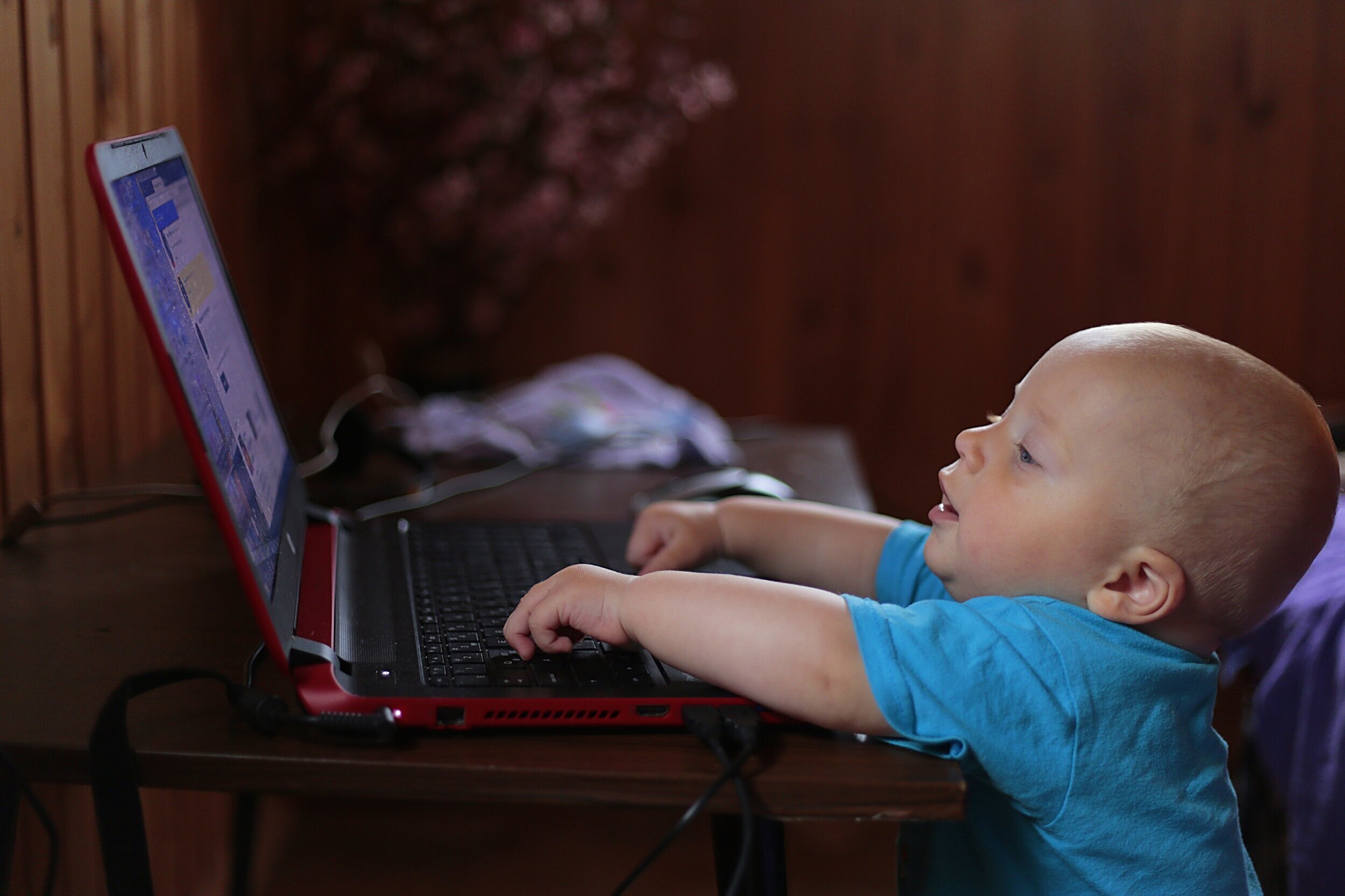5 Things Every Parent Should Know About Screen Time
A quick internet search on screen time and child development will make one thing very clear: screen time is not beneficial for developing young brains. Many studies have revealed the detrimental effects of too much time in front of screens, whether they be televisions, tablets, or phones. This is not good news for exhausted parents who are desperate not just to have a moment to themselves, but to attend to countless household tasks, provide attention to other children in the home, the list may go on and on. Providing a child with a tablet based game or video for 20 minutes may be a necessity. So with that understanding in mind, I’d like to take a step back from the countless guidelines you might find on Google, to explain why experts are harping on the need to decrease screen time for kids from a speech and language perspective (spoiler alert - it’s not just about the screens!).
1. Kids don’t learn language from screens.
Yes, some television programs are more educational than others. Yes, some apps and games are superior. However, young children (by this I mean infants and toddlers) do not possess the symbolic and attentional skills needed to learn from digital media. Expecting your child to learn how to talk from watching television is like me expecting to learn how to be a gymnast from watching Cirque du Soleil. I don’t have the experience to translate what I’m seeing into usable knowledge or skills. Simply put, children cannot take what they’ve seen on a TV show and use it in “real life”. Interactions with YOU are exponentially more valuable than anything they might experience through a screen. Interactive shows are not the same as interactions with YOU! Children need hands on exploration and real life social interactions in the real world in order to be able to function in the real world. So the next time you feel like you need to prop your child in front of the TV while you cook dinner or get ready for the day, instead try propping them in front of or next to you. I bet they will watch - and better yet, you can talk about everything you’re doing!
Most anything you read about early language development will tell you that the more language a child hears the better. And this is true. However, the best way for a child to learn language comes from reciprocal interactions, meaning you and the child are engaging together. Yet another reason that language input from a screen is not as impactful as interacting with you and others in your child’s environment. You may be thinking - what does reciprocal interaction look like when your child isn’t talking yet? Good question. Something as simple as pointing or reaching counts as a conversational “turn”. So if your child points to a bird, and you say, “Look! It’s a bird!”, that input is much more meaningful than your child seeing a bird on the TV screen.
Let’s take a step back even further and think about the missed opportunities that may occur if a child is watching a screen for several hours a day. That time would be much better spent in creative play and interactions with other children and caregivers. Young children need these opportunities to develop. Time spent outside, being active, and playing is crucial for development across the board.
2. The issue is bigger than just the screens.
The issue is also bigger than just language. The World Health Organization (W.H.O.) recently released new guidelines on physical activity, sedentary behavior, and sleep for children under 5 years of age (I know, I said we would take a step back from guidelines, but bear with me). These guidelines show us that the issue isn’t just about time spent in front of a screen. The real issue here is physical activity and overall health. According to the W.H.O., the number of obese people worldwide has nearly tripled since 1974. This is a BIG DEAL. And establishing healthy exercise (and yes, screen time) habits early on can have a major impact on health throughout their lifespan. These guidelines highlight the need for children to be physically active several times a day and in a variety of different ways. They also recommend that when sedentary, reading and storytelling is preferable to screen time. Being in front of a screen has hidden costs, not only is it detrimental, but it takes away opportunities to build good habits.
3. Passive screen time counts too.
Unfortunately, it isn’t just a child’s screen time that matters - so does ours. Research shows us that parent’s background television use (those episodes of Friends running on Netflix in the background) has a negative impact on parent-child interactions. So called “passive” screen time isn’t passive at all - it comes with a cost. We also know that your media habits are a strong predictor of your child’s media habits, so it’s a good idea to give your child a good example of less TV watching and more time reading. Don’t get me wrong, I love a good Netflix binge as much as anyone, but it’s important to be aware of the fact that passive screen time may have more of an impact than we think.
This also applies to mobile devices. When we are on our phones, scrolling through Instagram or Facebook, we are less likely to have verbal and non-verbal interactions with our children. Think about the importance of reciprocal interactions mentioned above. If you are at the park with your child, and your child points to a bird up in the sky, you will miss the opportunity for engagement if you are looking at your phone. Those missed opportunities add up quickly (remember, reciprocal interactions are the best way to teach language!).
4. Screens are everywhere!
Let’s take a moment to consider not only all of the screen types we have in our daily environment, but all of the uses we have for screens. We have so many options for movies and television shows, not to mention the social media outlets most of us subscribe to, in addition to addictive games and apps. Our overall options for media have changed drastically over the past few years, and don’t seem to be slowing down or decreasing anytime soon. Because of this, it is all the more important for us to be aware of our daily screen time. Not to mention there are buildings full of professionals strategizing ways to make these things more addictive to you and your children. People can get advanced degrees in persuasive technology!
A recent article from The Atlantic describes the dangers of “distracted parenting”. Again, the importance of reciprocal, back and forth conversations is emphasized, as well as the severe disruption caused by parental screen time. We’ve all been in a situation in which we are having a nice conversation with a friend and that friend gets a text and suddenly focuses on their phone instead of whatever you were in the middle of saying. Annoying right? And not only annoying, but awkward and incredibly disruptive to the flow of your conversation. It is the same thing that happens when you interrupt the all important reciprocal interaction with your child.
5. Don’t feel guilty - some screen time is actually OK.
No one is expecting you to move to a cabin in the woods away from technology. Remember, screens are everywhere! And in today’s world, kids need to be savvy technology users, so screens are inevitably going to be a part of their lives. As I’ve mentioned, the W.H.O. recommends zero minutes of screen time for children under 12 months of age. The American Academy of Pediatrics updated their guidelines as well, recommending no screen time for children under 18 months of age. This is not to say a few minutes of screen time is going to completely interrupt your child’s development. The main point is that kids don’t learn language from a screen. This is especially important to note in the age of Baby Einstein among others, promoting interactive and educational programming. A study out of the University of Washington found that parents are certainly conflicted about screen time, and their primary reason for allowing their child to have screen time was to attend to necessary tasks like folding laundry or giving attention to another child in the household. As I mentioned above, for many families it may feel like a necessity. Further proof of this conflict parents face - a national survey found that technology overuse use was the number one fear of parents of teenagers. So it seems the conflict does not diminish as children grow older. The main point here is that parents should be well informed and ultimately need to determine what’s best for their family.
One final point - the W.H.O. recommends no more than 60 minutes of sedentary screen time for children 2 years of age, and this experience can be greatly enhanced by adult interaction with the child. What does this look like? This video of an adorable (and very empathetic) little girl watching a movie with her mom gives us a nice example. And does anyone remember this viral video of a baby watching TV with his dad? If parents watch programs with their children, they can highlight and discuss new words and ideas. This is what can contribute to language learning.
If you’re concerned about your child’s screen time exposure, there are several amazing (and free!) resources online. Here is a great resource to help you and your family to come up with a family media plan:
https://www.healthychildren.org/English/media/Pages/default.aspx
If you are concerned about your child’s speech and language development, your best option is always to speak with your child’s healthcare providers to determine if a speech and language referral is necessary.
And if you’re looking for a comprehensive parent centered course on early language development, check out my Let’s Get Talking! course here.
For further reading, here are some references for the studies I’ve mentioned above.
Anderson, D. R., & Pempek, T. A. (2005). Television and very young children. American Behavioral Scientist, 48(5), 505-522.
Barr, R. (2013). Memory constraints on infant learning from picture books, television, and touchscreens. Child Development Perspectives, 7(4), 205-210.
DeLoache, J. S., Chiong, C., Sherman, K., Islam, N., Vanderborght, M., Troseth, G. L., ... & O’Doherty, K. (2010). Do babies learn from baby media?. Psychological Science, 21(11), 1570-1574.
Jago, R., Stamatakis, E., Gama, A., Carvalhal, I. M., Nogueira, H., Rosado, V., & Padez, C. (2012). Parent and child screen-viewing time and home media environment. American journal of preventive medicine, 43(2), 150-158.
Kirkorian, H. L., Pempek, T. A., Murphy, L. A., Schmidt, M. E., & Anderson, D. R. (2009). The impact of background television on parent–child interaction. Child development, 80(5), 1350-1359.
Radesky, J., Miller, A. L., Rosenblum, K. L., Appugliese, D., Kaciroti, N., & Lumeng, J. C. (2015). Maternal mobile device use during a structured parent–child interaction task. Academic pediatrics, 15(2), 238-244.
Radesky, J. S., Kistin, C. J., Zuckerman, B., Nitzberg, K., Gross, J., Kaplan-Sanoff, M., & Silverstein, M. (2014). Patterns of mobile device use by caregivers and children during meals in fast food restaurants. Pediatrics, 133(4), e843-e849.
Richert, R. A., Robb, M. B., Fender, J. G., & Wartella, E. (2010). Word learning from baby videos. Archives of pediatrics & adolescent medicine, 164(5), 432-437.
Schmidt, M. E., Pempek, T. A., Kirkorian, H. L., Lund, A. F., & Anderson, D. R. (2008). The effects of background television on the toy play behavior of very young children. Child development, 79(4), 1137-1151.
Wen, L. M., Baur, L. A., Rissel, C., Xu, H., & Simpson, J. M. (2014). Correlates of body mass index and overweight and obesity of children aged 2 years: findings from the healthy beginnings trial. Obesity, 22(7), 1723-1730.



